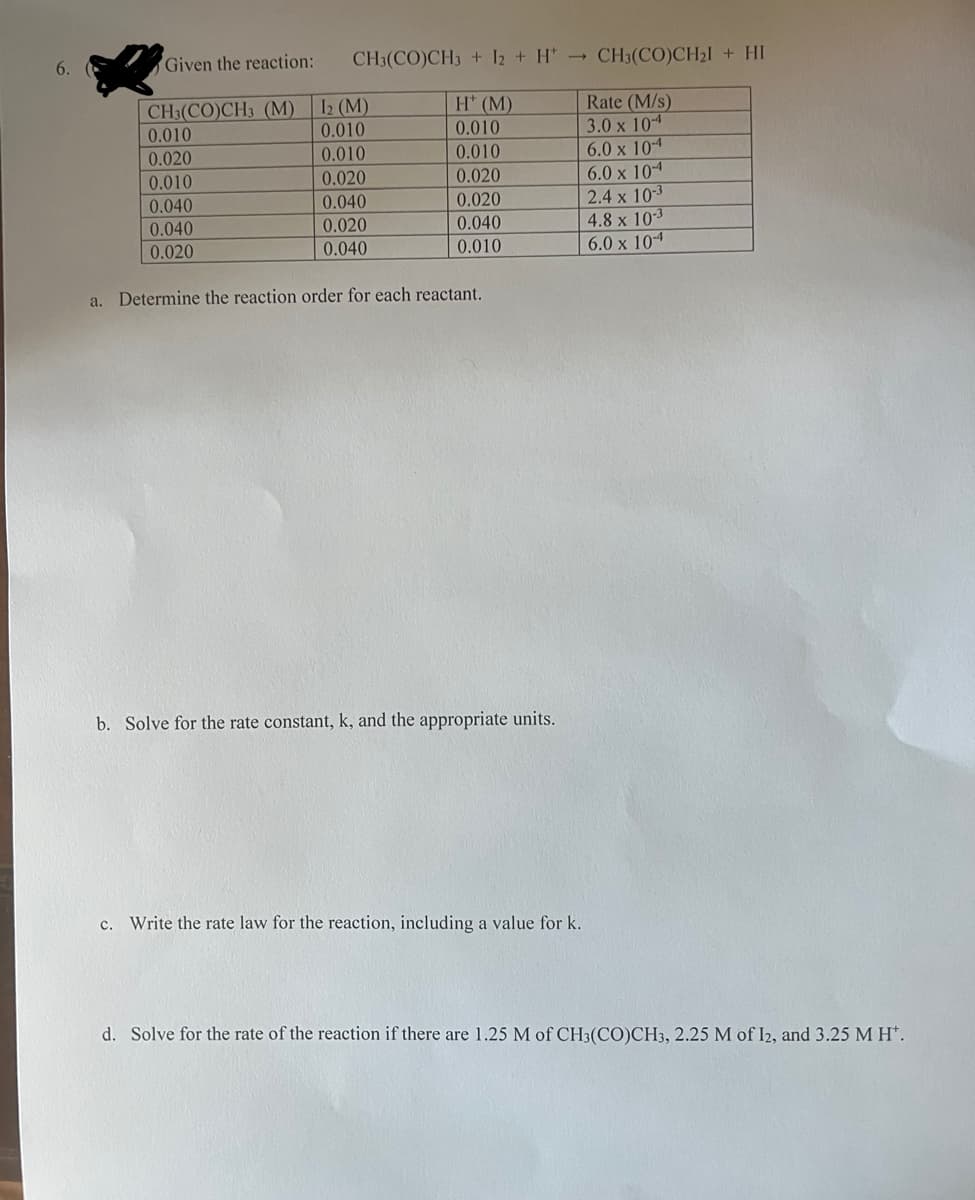6. Given the reaction: CH3(CO)CH3 (M) 0.010 0.020 0.010 0.040 0.040 0.020 CH3(CO)CH3 12 (M) 0.010 0.010 0.020 0.040 0.020 0.040 + L + H* H* (M) 0.010 0.010 0.020 0.020 0.040 0.010 a. Determine the reaction order for each reactant. b. Solve for the rate constant, k, and the appropriate units. CH3(CO)CH2! + HI Rate (M/s) 3.0 x 10-4 6.0 x 10-4 6.0 x 104 2.4 x 10-3 -> c. Write the rate law for the reaction, including a value for k. 4.8 x 10-3 6.0 x 10-4 d. Solve for the rate of the reaction if there are 1.25 M of CH3(CO)CH3, 2.25 M of I2, and 3.25 M H*.
6. Given the reaction: CH3(CO)CH3 (M) 0.010 0.020 0.010 0.040 0.040 0.020 CH3(CO)CH3 12 (M) 0.010 0.010 0.020 0.040 0.020 0.040 + L + H* H* (M) 0.010 0.010 0.020 0.020 0.040 0.010 a. Determine the reaction order for each reactant. b. Solve for the rate constant, k, and the appropriate units. CH3(CO)CH2! + HI Rate (M/s) 3.0 x 10-4 6.0 x 10-4 6.0 x 104 2.4 x 10-3 -> c. Write the rate law for the reaction, including a value for k. 4.8 x 10-3 6.0 x 10-4 d. Solve for the rate of the reaction if there are 1.25 M of CH3(CO)CH3, 2.25 M of I2, and 3.25 M H*.
Chemistry & Chemical Reactivity
10th Edition
ISBN:9781337399074
Author:John C. Kotz, Paul M. Treichel, John Townsend, David Treichel
Publisher:John C. Kotz, Paul M. Treichel, John Townsend, David Treichel
Chapter14: Chemical Kinetics: The Rates Of Chemical Reactions
Section: Chapter Questions
Problem 59GQ: When heated, tetrafluoroethylene dimerizes to form octafluorocyclobutane. C2F4(g) C4F8(g) To...
Related questions
Question

Transcribed Image Text:6.
Given the reaction:
CH3(CO)CH3 (M) | B(M)
0.010
0.010
CH3(CO)CH3 + I2 + H* → CH3(CO)CH2I + HI
H* (M)
Rate (M/s)
0.010
3.0 x 10-4
0.010
6.0 x 10-4
0.020
6.0 x 104
0.020
2.4 x 10-3
0.040
4.8 x 10-3
0.010
6.0 x 104
0.010
0.020
0.010
0.040
0.040
0.020
0.020
0.040
0.020
0.040
a. Determine the reaction order for each reactant.
b. Solve for the rate constant, k, and the appropriate units.
c. Write the rate law for the reaction, including a value for k.
d. Solve for the rate of the reaction if there are 1.25 M of CH3(CO)CH3, 2.25 M of I2, and 3.25 M H*.
Expert Solution
This question has been solved!
Explore an expertly crafted, step-by-step solution for a thorough understanding of key concepts.
Step by step
Solved in 5 steps with 4 images

Knowledge Booster
Learn more about
Need a deep-dive on the concept behind this application? Look no further. Learn more about this topic, chemistry and related others by exploring similar questions and additional content below.Recommended textbooks for you

Chemistry & Chemical Reactivity
Chemistry
ISBN:
9781337399074
Author:
John C. Kotz, Paul M. Treichel, John Townsend, David Treichel
Publisher:
Cengage Learning

Chemistry & Chemical Reactivity
Chemistry
ISBN:
9781133949640
Author:
John C. Kotz, Paul M. Treichel, John Townsend, David Treichel
Publisher:
Cengage Learning

Chemistry by OpenStax (2015-05-04)
Chemistry
ISBN:
9781938168390
Author:
Klaus Theopold, Richard H Langley, Paul Flowers, William R. Robinson, Mark Blaser
Publisher:
OpenStax

Chemistry & Chemical Reactivity
Chemistry
ISBN:
9781337399074
Author:
John C. Kotz, Paul M. Treichel, John Townsend, David Treichel
Publisher:
Cengage Learning

Chemistry & Chemical Reactivity
Chemistry
ISBN:
9781133949640
Author:
John C. Kotz, Paul M. Treichel, John Townsend, David Treichel
Publisher:
Cengage Learning

Chemistry by OpenStax (2015-05-04)
Chemistry
ISBN:
9781938168390
Author:
Klaus Theopold, Richard H Langley, Paul Flowers, William R. Robinson, Mark Blaser
Publisher:
OpenStax

Chemistry: An Atoms First Approach
Chemistry
ISBN:
9781305079243
Author:
Steven S. Zumdahl, Susan A. Zumdahl
Publisher:
Cengage Learning

Chemistry: Matter and Change
Chemistry
ISBN:
9780078746376
Author:
Dinah Zike, Laurel Dingrando, Nicholas Hainen, Cheryl Wistrom
Publisher:
Glencoe/McGraw-Hill School Pub Co

Chemistry: Principles and Reactions
Chemistry
ISBN:
9781305079373
Author:
William L. Masterton, Cecile N. Hurley
Publisher:
Cengage Learning